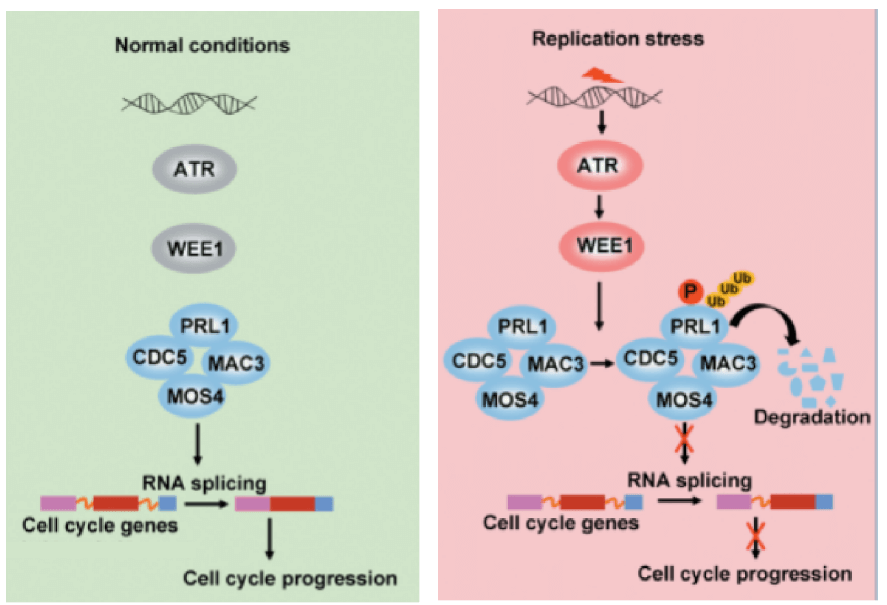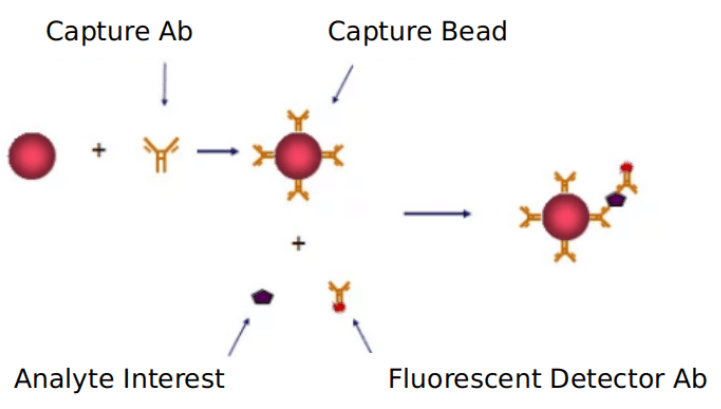Wee1 signaling pathway
Based on Luminex echnology platform, Creative Proteomics provides analysis services for key targets of wee1 signaling pathway.
Inhibition or genetic knockdown of Wee1 not only abrogates its kinase function but also attenuates ATR/Chk1 pathway activation in cells subjected to genotoxic stress. Wee1 inhibition requires Polo-like kinase 1 (Plk1) and cyclin-dependent kinase 1 and 2 (Cdk1/2) to reduce ATR/Chk1 activity. By activating Plk1 and Cdks, Wee1 inhibition reduced CtIP and Claspin levels, explaining the impaired ATR/Chk1 activity. Therefore, the consistent signaling pathway from Wee1 inhibition to Chk1 activity impaired mechanism analyzes that Wee1 inhibitors not only deregulate the cell cycle process, but also enhance the replication stress and chemical sensitivity to nucleoside analogs.
 As a downstream protein in the (V600E)B-RAF pathway, WEE1 is involved in the treatment of xenograft tumors. When the protein levels of mitogen-activated protein kinase 1/2, (V600E)B-RAF, and extracellular signal-regulated kinase 1/2 decrease, the use of siRNA reduces the level of WEE1 in melanoma cells compared with other identified kinases . The expression level of WEE1 in the tumors of melanoma patients is higher than that observed in normal human melanocytes. Targeting these proteins reduced tumor development by approximately 70%. In addition, when drugs using mitogen-activated protein kinase inhibit (V600E) B-RAF and target the upstream (V600E) B-RAF pathway, the protein or activity level of WEE1 in melanoma cells is reduced. Therefore, WEE1 is a target and biomarker of therapeutic effect, located downstream of B-RAF in melanoma (V600E).
As a downstream protein in the (V600E)B-RAF pathway, WEE1 is involved in the treatment of xenograft tumors. When the protein levels of mitogen-activated protein kinase 1/2, (V600E)B-RAF, and extracellular signal-regulated kinase 1/2 decrease, the use of siRNA reduces the level of WEE1 in melanoma cells compared with other identified kinases . The expression level of WEE1 in the tumors of melanoma patients is higher than that observed in normal human melanocytes. Targeting these proteins reduced tumor development by approximately 70%. In addition, when drugs using mitogen-activated protein kinase inhibit (V600E) B-RAF and target the upstream (V600E) B-RAF pathway, the protein or activity level of WEE1 in melanoma cells is reduced. Therefore, WEE1 is a target and biomarker of therapeutic effect, located downstream of B-RAF in melanoma (V600E).
As a tyrosine kinase, Wee1 is overexpressed in many cancers such as hepatocellular carcinoma, luminal, glioblastoma, and HER2-positive breast cancer subtypes. Wee1 directly interacts with histone H2B and inactivates the CDK2/cyclin B complex by phosphorylation of CDK2, thereby terminating the cell cycle to regulate G2-M transition. Inhibition of Wee1 has been shown to cause DNA damage due to unrestricted replication and enhance the effectiveness of DNA damage therapies (Do, Doroshow, and Kummar, 2013; Guertin et al., 2013). Many clinical trials have proved that Wee1 inhibitors have a wide range of effects in colorectal cancer, acute myeloid leukemia, lung cancer, prostate cancer, breast cancer, and head and neck cancer.
Our detectable targets:
| RTK | PI3K | TYK2 | STAT1 | STAT2 | STAT3 |
| GAS | IRF9 | MEKK1 | p38 | RIP1 | TRAF5 |
| TNFR | ISGF3 | MSK2 | PI3K | TBK1 | Vav |
| MHC-II | IRS1 | MEK6 | p50 | SLP76 | TRAM |
| STAT5 | IRAK4 | JNK | MYD88 | Rac1 | TLR4 |
| PSGL1 | IRS2 | MSK1 | TLR3 | Tak1 | TRIF |
| CREB | IRF3 | MAPK | NAP1 | Rel | TLR9 |
| CD3 | IRF5 | MEK3 | p38MAPK | SH2 | TRAF6 |
| Fas | ISRE | mTOR | PKR | RIG-1 | TRAF3 |
| TCR | icam1 | Mda-5 | NFκB |
Technology platform:
We provide Luminex technology for wee1 signaling pathway analysis.
Luminex technology is a multifunctional liquid phase analysis platform developed on the basis of colored microspheres, laser technology, applied fluidics and high-speed digital signal processing technology. The core is to encode polypropylene microspheres or magnetic microspheres with fluorescent dyes. By adjusting the different ratios of the two fluorescent dyes, up to 100 microspheres with different fluorescence spectra can be obtained. Antigen-antibody, enzyme-substrate, ligand-receptor binding reactions and nucleic acid hybridization reactions are performed on microspheres with different fluorescence encoding. Qualitative and quantitative analysis by laser detection of microsphere coding and reporter fluorescence separately.
As a tyrosine kinase, the Wee1 signaling pathway is widely used in lung cancer, colorectal cancer, prostate cancer, acute myeloid leukemia, breast cancer in clinical trials, head and neck cancer.
In addition to Luminex Multiplex Assay, Enzyme-linked immunosorbent assay (ELISA), Flow cytometry (FACS analysis) technology can also be provided to meet other customer needs.
Advantages of wee1 signaling pathway detection:
- High-throughput: Simultaneous analysis of multiple target molecules in the same sample. Theoretically, the detection flux is equal to the number of types of microspheres, that is, up to 100 types.
- Low sample consumption: Because 100 different target molecules can be detected in the same reaction well at the same time, the amount of sample is greatly saved; and because of the small size of the microspheres, as little as 1 puL of samples can be detected.
- Simple and fast operation: Because it is a liquid phase system, the reaction time is greatly shortened, and multiple cytokine detection can be completed within 2 to 3 hours.

Application of our service:
- To study the regulation mechanism of wee1 signal pathway in disease
- To study the effect of each virus on wee1 signaling pathway
- To study the effects of drugs or therapies on wee1 signaling pathways
Creative Proteomics has developed a signal pathway target detection platform. We are not limited to providing wee1 signal path detection services, but can also provide other signal path detection services. If you want to detect other targets, please contact us and we will customize the service for you. Look forward to working with you.
References:
- Sharma A , Madhunapantula S , et al. Identification of Aurora Kinase B and Wee1-Like Protein Kinase as Downstream Targets of V600EB-RAF in Melanoma. The American Journal of Pathology, 2019, 182(4): 1151-1162.
- Saini P, Li Y, et al. Wee1 is required to sustain ATR/Chk1 signaling upon replicative stress. Oncotarget, 2019, 6(15).



